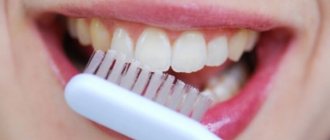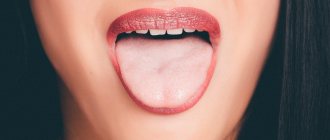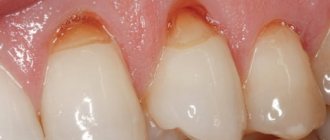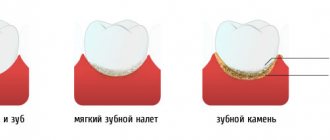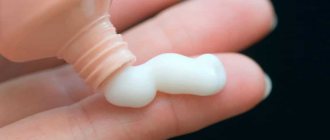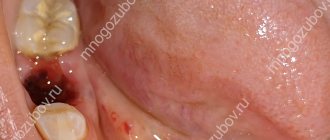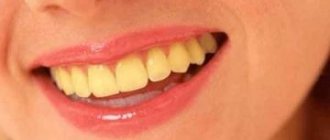How many days should you follow the diet? What can you not eat and drink? What can you do?
Example of a daily diet Other recommendations In the case of home whitening Who among us does not dream of a snow-white smile. Dentists have made such a dream accessible to almost everyone. It's easy to get a sparkling white smile, but how to maintain it?
One of the conditions is the diet after teeth whitening.
Why are restrictions needed?
After the procedure, tooth enamel:
- Becomes more sensitive
.
Over time, the increased sensitivity goes away, but in the first 48 hours
, the reaction to substances contained in food can be severe. - Even gentle manipulation increases its permeability
. Acids contained in some products may increase the risk of deterioration of the surface layer. - Becomes more porous
. The top layer of dentin is temporarily exposed. Pigments can easily penetrate it and stain it, ruining the entire procedure.
There is no bad breath or dryness.
Most smokers, especially heavy smokers, are bothered by bad breath. Therefore, the question arises, are there any such consequences from the use of devices used to heat tobacco? Dentists assure that such consequences are unlikely from IQOS. After directly using IQOS, there is no smell of tobacco on your breath, nor on your hands, which is also an advantage. The only specific smell that someone may not like is the smell of smoke during smoking itself.
As a rule, there is no dry mouth. Due to the lack of exposure to smoke, the condition of the oral cavity hardly worsens. Users also notice that due to the absence of any combustion products and even resins, there is therefore no unpleasant bitterness in the mouth.
How many days should you follow the “white diet” after teeth whitening?
The whitening process is not completed the moment the patient gets out of the chair. The effect needs to be consolidated. For this, certain restrictions are introduced. Very strict - for 48 hours, but dentists recommend not to take risks and stick to a “transparent” diet for 2 weeks
. So you will definitely amaze others with whiteness for many months. During this time, the tooth enamel will be restored and restrictions can be removed. Although it should be remembered that uncontrolled use of products with coloring pigments will cause the shine and sparkle of the enamel to fade quite quickly. But reasonable use, on the contrary, will prolong the effect.
Is the risk of periodontal disease reduced?
Periodontal disease is a very serious disease in which the last stage of gum inflammation occurs. Eventually, a person may begin to lose teeth, resulting in an inability to function normally, eat their favorite foods, and drink their favorite drinks. This will also lead to a lot of money spent.
Periodontal disease can be of different types, but its main cause is plaque on the teeth, which appears as a result of a variety of bad and not so bad habits. For example, frequent consumption of coffee, tea, smoking cigarettes, peculiarities of the composition of saliva, improper chewing, endocrine diseases, fixed orthodontic structures, etc. lead to the appearance of plaque on the teeth, which hardens over time, and when smoking, drinking coffee, and the like, the same the plaque becomes darker.
The types of periodontal disease include:
- supragingival calculus;
- subgingival calculus.
There is also a species called "stone bridge". This is the name for the phenomenon when periodontal disease covers two or more teeth in a row.
There is evidence of a study lasting several days that compared the effects of cigarette smoke and steam from a heater on the mucous membrane of the human mouth, his gums and, in fact, his teeth. It was found that the cytotoxicity of cigarettes is quite high, unlike IQOS.; However, steam also has an effect on the oral cavity, although not as strong.
What not to eat after teeth whitening
Darkening, pigmentation, and the appearance of spots are promoted by 3 factors: chromogens (substances that acquire color during oxidation), acids and tannins (tannins). They are found in many foods and can stain teeth, cause an unpleasant reaction, and even destroy enamel.
Products containing acids
- Citrus fruits e
. Even sweet tangerines contain a large amount of acid, which corrodes the protective layer. - Tomatoes
. They are not only red, but also sour. - Carbonated drinks
. They are carbonated with carbon monoxide, so even colorless carbonation is the enemy of enamel. - Fruit juices
. In terms of the amount of acids, they are comparable to carbonated drinks. - Pickles and marinades
. Vinegar is a strong acid that aggressively destroys surface layers.
Products containing acids
Products containing pigments
- Tea
(green and black),
coffee
. The tannins contained in these drinks have a cumulative effect. One cup may not stain your teeth, but there are no guarantees about the fifth. - Wine
. And white wine too. Red wine has a lot of coloring pigments, but any wine has acids. - Sweet carbonated drinks
are also included in this group. Most of them contain acids that destroy enamel, as well as pigments that leave stains on it. - Dark fruits and berries
. The combination of acids and pigments can ruin the whitening result. All red, blue, purple berries and fruits should go into oblivion for 2 weeks. - Chocolate
and colored candies. Sugar and pigments are a bad combination for tooth enamel. - Sauces
. Avoid soy sauce, balsamic vinegar, ketchup. Or better yet, any sauce at all. Most contain acids, tannins, pigments, or all three.
Products containing coloring pigments
It is better to heat-treat products that raise doubts.
Changes in enamel color in smokers
In the process of smoking a cigarette, smoke enters the human body, which contains tar, nicotine and combustion products. They stick tightly to tooth enamel, staining it an unnatural color. Smokers often have yellow or brown teeth. In this case, localized areas of enamel staining in the form of spots or lines may be observed, indicating the most affected areas.
Features of stains on enamel:
- in the spaces between the teeth - a sign of the formation of tartar, which accumulates a greater amount of coloring substances due to its porous structure;
- along the gum line - a sign of recession, characterized by weakening of the gums, exposure of the neck of the teeth and inflammation of the soft tissues;
- the inner side of the dentition - signals an increased acidic environment as a result of the interaction of saliva and cadmium sulfate (a product of burning a cigarette), the formation of tartar and inflammation of the gums.
Long-term smoking leads to the penetration of dyes deep into the tissue of the dental crown. Not only enamel is negatively affected, but also hard tissues up to dentin. Therefore, the only solution to restore a snow-white smile is professional whitening.
What is possible
Fortunately, the list of products allowed after whitening is quite extensive. It includes:
- White meat
(turkey, chicken),
fish
. They contain no acids or dyes. They provide us with protein without harm to health. - Tofu
. An excellent source of protein for vegetarians and vegans. - Dairy products
without dyes. Classic yogurt, milk without additives, cottage cheese, sour cream will provide you with the calcium you need after the intervention. - Cheeses. It is better to avoid exotic ones due to increased sensitivity.
- Cereals, pasta
and
bread
. Most cereals and pasta are allowed on the “white diet”. Problems can only arise with colored pasta or dumplings made from red flour. - Light fruits and berries
. They provide our body with vitamins. - Light vegetables
. Provide fiber without damaging teeth. - Water
. It definitely won’t leave dark spots or destroy the enamel. It's the best choice for hydration, oral health and a bright smile.
About the effect on implants
Low chance of implant failure.
Implant failure is indicated by:
- inflammation and swelling of the gums, accompanied by pain;
- bleeding gums;
- strong pain;
- body temperature is higher than 38oC;
- discharge of pus and bad breath;
- mobility or, in fact, loss of the structure installed by the dentist.
This is due to damage to the oral cavity by the high temperature of the smoke, as a result of which the layer of the epidermis becomes thicker, and the risk of developing peri-imlantitis increases. This usually occurs from smoking cigarettes.
However, there is information that not only smoke causes dental problems, but also factors such as large temperature changes, from hot smoke to cold air. This is also worth considering.
Approximate daily diet
Individual preferences influence what people eat after teeth whitening. A general recommendation would be to not drink alcohol. Wine contains tannins, and beer contains acids. Strong alcohol penetrates through the enamel pores, damaging the integrity of dentin. Therefore, it is better to exclude alcohol from the list of products for a white diet.
Breakfast
(options):
- porridge (with milk, with water);
- omelette;
- banana smoothie;
- buttered toast;
- classic yogurt;
- cottage cheese.
Dinner:
- mushroom soup;
- baked fish;
- potato;
- vegetable soup (avoid dark vegetables);
- poached chicken;
- chicken broth with dumplings.
Dinner:
- sandwich with chicken or cream cheese;
- pasta with white sauce;
- rice with chicken, fish, mushrooms;
- turkey salad;
- white beans;
- cauliflower.
Snacks:
- yogurt;
- baked apple;
- banana;
- cucumber;
- pear;
- white grapes.
By combining products and coming up with something of your own, you can easily survive for 2 weeks without noticing any restrictions.
It is important to ensure that the diet is complete, with a variety of recipes. For the body, the supply of vitamins and nutrients is important. Monotonous food and strict restrictions can lead to intestinal upset, vitamin deficiency, and demineralization of teeth.
On the other hand, you should not panic if you accidentally ate something that is not recommended to eat after whitening. Brush your teeth or rinse your mouth right away, the main thing is not to repeat the mistakes.
Nutrition principles:
- avoid “colored” foods;
- do not drink alcohol;
- to drink a lot of water;
- subject “doubtful products” to heat treatment.
The white diet is not limited to the list of foods that can be eaten after teeth whitening. The dentist will also give other care tips that will strengthen your teeth and prolong the duration of the procedure.
Bleaching and smoking IQOS
After bleaching, it is not recommended to smoke cigarettes, drink strong tea, coffee, or eat foods with dyes, as excessive staining of teeth is possible within one week. Your daily diet should include foods high in calcium and fluoride, namely dairy products, eggs and fish. And, conversely, from your daily diet you need to exclude foods that can stain the enamel, for example, coffee, berries, juices. It is also recommended to eat solid and hot foods. The longer the patient adheres to the diet and does not consume dyes, the longer the whitening effect lasts. After the procedure, you can ask your dentist whether you can smoke IQOS cigarettes after brushing your teeth, what products are allowed for consumption, and when to come for the next session. Usually the specialist asks you to refrain from smoking in all its forms for some time, including the use of electronic cigarettes and IQOS.
Scientists have conducted studies in which they found that in the case of regular smoking, after bleaching, the particles contained in cigarettes quickly darken the enamel. The same method was applied to the teeth using IQOS systems. In this case, virtually no darkening was observed.
However, to minimize the risk of unwanted effects on enamel, it is recommended to wait a few hours before using IQOS. You should give up regular cigarettes for a couple of days, ideally 3-5, and only then start smoking.
If it is impossible to quit smoking tobacco for a few days, then it is better not to undergo teeth whitening. Its effectiveness will decrease several times if you do not follow the recommendations of dentists in the future. Permission to smoke IQOS is obtained not only after bleaching. You can also find out from your dentist whether you can smoke IQOS after tooth extraction, treatment of caries, periodontitis, or pulpitis.
Most often, in addition to whitening, people ask the question of whether it is possible to smoke IQOS after tooth extraction. The dentists’ answer here is clear: no, because there is an open wound in the mouth, which is not recommended to be exposed not only to smoke, but also to steam. You should distract yourself from the thought of smoking for at least 2-3 hours.
After cleaning, you should refrain from smoking IQOS for 2 hours, since as a result of removing tartar, an unprotected gap sometimes appears between the tooth and gums.
Reviews from users of the electronic tobacco heating system indicate isolated unpleasant sensations that occur when consuming IQOS immediately after brushing your teeth, but these are rather personal impressions.
Thus, using IQOS is much less harmful than consuming regular cigarettes. This applies to general health and the direct impact of IQOS on teeth. It is important to follow the recommendations of dentists and not harm your own health.
What else
Recommendations after teeth whitening:
- Refrain from eating
for
2 hours
, give your body a chance to recover - Avoid cold and hot
. After dental procedures, sensitivity increases. Warm food will help avoid discomfort. - For some time after the procedure, you should brush your teeth after every meal.
- Dental floss
helps remove food debris that, when decomposed, can cause tooth decay and damage enamel. - Do not use whitening
toothpaste until sensitivity returns to normal. Then it can be used to maintain the effect 1-2 times a week. - If you don't have the strength to give up caffeine, use a straw.
But it is better not to drink it after bleaching for at least 48 hours.
The result of whitening in ROOTT dentistry
The essence of the whitening procedure
Teeth whitening is based on a couple of factors:
- Exposure to hydrogen peroxide entering the enamel and causing an oxidation process that destroys dyes.
- Ultraviolet, halogen or LED lamps and a laser beam speed up the reaction and make the procedure more effective.
After such an intervention, the teeth will become vulnerable:
- the enamel layer loosens, carious spots appear on it;
- sensitivity will increase;
- the likelihood of soft tissue irritation increases.
Proper dental care helps maintain the whitening effect for a long time and strengthen weakened enamel.
conclusions
So, smokers should take into account what dentists say about the effect of IQOS on the condition of teeth. If you have no desire to give up smoking, choosing devices for heating tobacco will most likely be more successful.
Although switching to IQOS may cause unpleasant symptoms, there will still be significantly less harm to health. Sticks for this device are a little more expensive than regular cigarettes, and here it’s worth deciding whether it’s worth saving on your health. Only IQOS causes addiction to nicotine in the same way as cigarettes. There are also unpleasant side effects and harm to health, so the greatest benefit for teeth, and health in general, will be a complete cessation of any type of smoking.
Hygienic care rules
Since the gums and dental tissues become more sensitive and weakened during the first few weeks, special hygiene requirements must be observed:
- Replacing the brush. Bacteria accumulate on the bristles over time, so it is recommended to change the dental plaque removal tool once every three months. After the whitening procedure, this must be done immediately, as the gums and enamel may be slightly injured. Even small cracks will become a path for pathogens to penetrate inside. You need to buy a brush with soft bristles, and after a few weeks replace it with a harder one.
- Competent selection of toothpaste. Products are chosen with low abrasiveness. This indicator indicates the strength of plaque abrasion, or, more simply, hardness. In the specifications it is indicated by the abbreviation RDA. It should be within 30 - 50 units. To strengthen the surface layer and saturate the enamel with microelements, pastes with fluoride or calcium are chosen. The higher the percentage of these substances, the better. If gum sensitivity is increased, then buy restorative gels with herbal extracts.
- Mouth rinses. After eating, be sure to rinse your mouth with clean water or mouthwash. If there is inflammation of the gums, use safe antiseptic solutions: Chlorhexidine, Miramestin, Rotokan. Do not rinse with herbal decoctions, as they can stain.
- Comprehensive care. To maintain hygiene at a high level, additional devices are used: interdental brushes, flosses, irrigators. If teeth have been additionally cleaned to remove supragingival or subgingival calculus, anti-inflammatory and regenerating drugs are applied to the gums, for example, Metragil Denta.
In order to always have white and healthy teeth, you need to undergo professional oral hygiene at the dentist once every six months.
